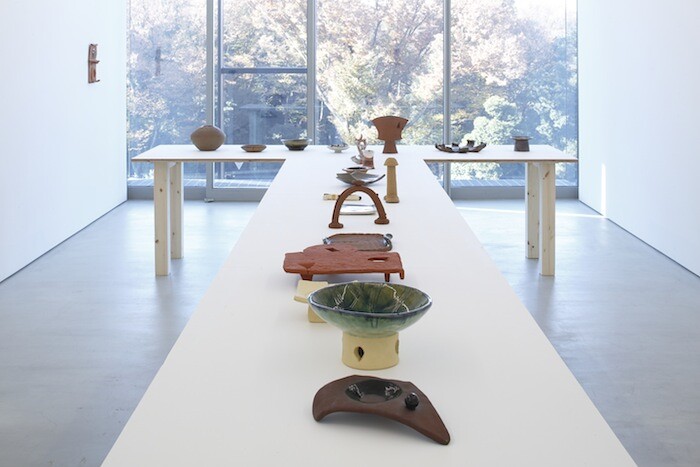Categories
Subjects
Authors
Artists
Venues
Locations
Calendar
Filter
Done
January 12, 2017 – Review
J.B. Blunk
Cameron Allan McKean

Pottery is place, folded and fired. It is soil, stone, flora, topography, and climate, massaged by human tradition and technique. In Japan, the placeness of ceramics has been taken to an extreme with local variations in style proliferating across the island nation. This sensitivity to place and materials echoes in the work of the late Californian craftsman and artist James Blain Blunk (1926–2002), whose pottery is on display for the first time in Japan since the 1950s.
Though best known for the semi-functional redwood sculptures he carved with a chainsaw in the 1960s and ’70s, Blunk was also a painter, weaver, jeweler, woodworker, and, briefly, part-time sheep wrangler in the course of a restless career. But before all this, Blunk was among the first westerners to study under Japan’s master potters. On furlough from the Korean War, to which Blunk had been drafted in 1949, he met the artist Isamu Noguchi by chance in a Mingei (folk art) store in Tokyo, an encounter which would lead him to some of Japan’s most revered craftsmen. When Blunk was discharged from service in 1952 he became an apprentice in Rosanjin Kitaoji’s Kamakura studio, south of Tokyo, before leaving to study for eighteen months …
October 19, 2011 – Review
Sharon Lockhart’s “Podworka”
Lyra Kilston

In a dim, narrow courtyard, a pothole, ringed by pieces of broken concrete, has filled with dark water. The camera lingers on this scene in one unmoving five-minute shot, as two young boys meander around the confined concrete area, in Sharon Lockhart’s most recent film, Podworka (2009). One of the boys rides his small bicycle up to the pothole and regards it with intent curiosity. He starts an absorbing game of repeatedly dipping the bicycle’s wheels into the water and reacts by gleefully clapping his hands and laughing—the dirty puddle, an eyesore and inconvenience to some, is to him a toy and a marvel.
Filmed in the city of Lodz, Poland, Podworka consists of six scenes of children playing in different industrial-looking locations, and each scene is a static five-minute take. In Polish, Podworka translates to yard or backyard, and in this case, they are mostly blighted or graffiti-strewn, with a scraggly weed or two. Lockhart seems to have chosen her locations based on their function as impromptu playgrounds, and it is unclear whether she surreptitiously filmed many hours of footage to capture the children’s games, or asked them to play in front of her camera. The children’s blithe patterns of …